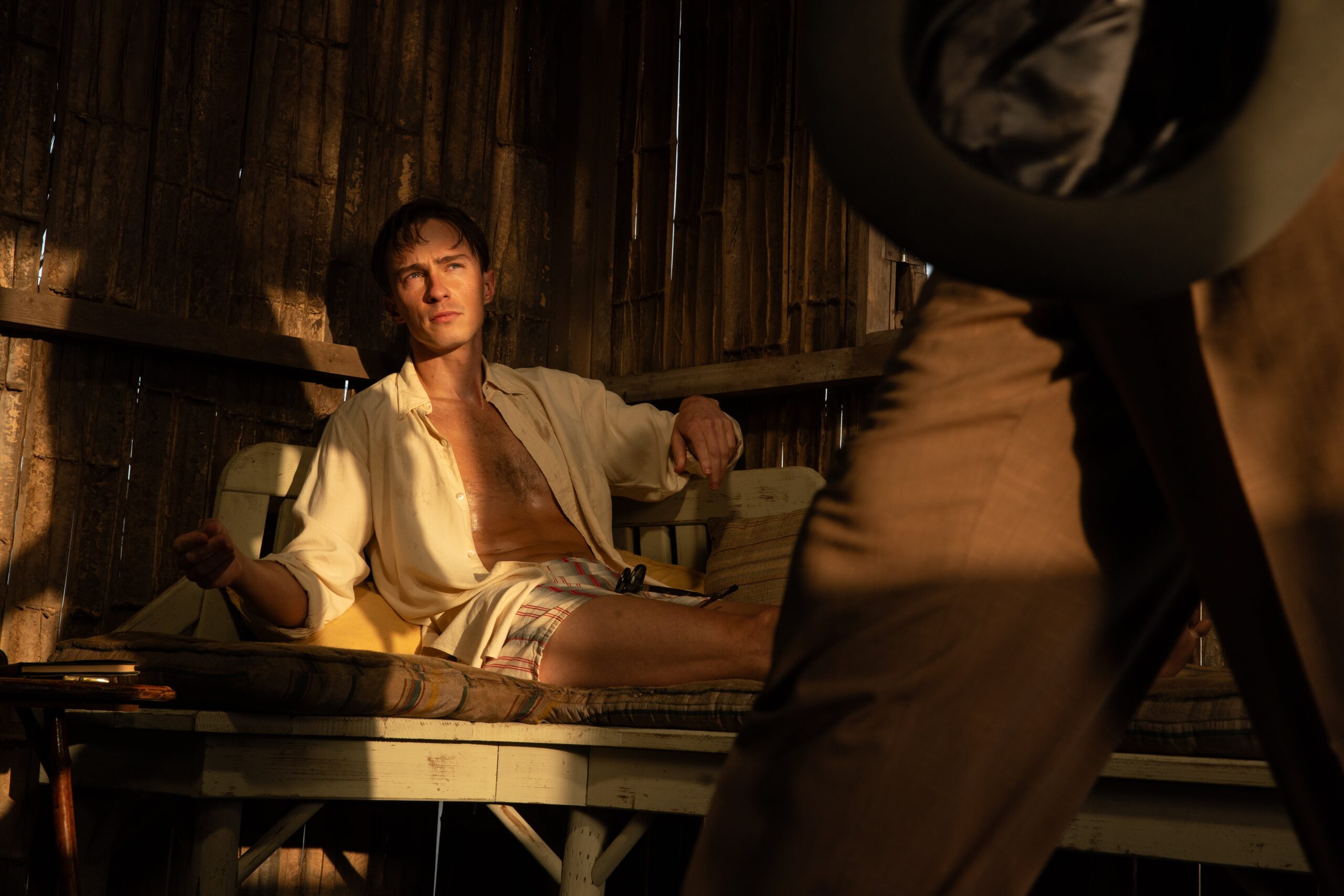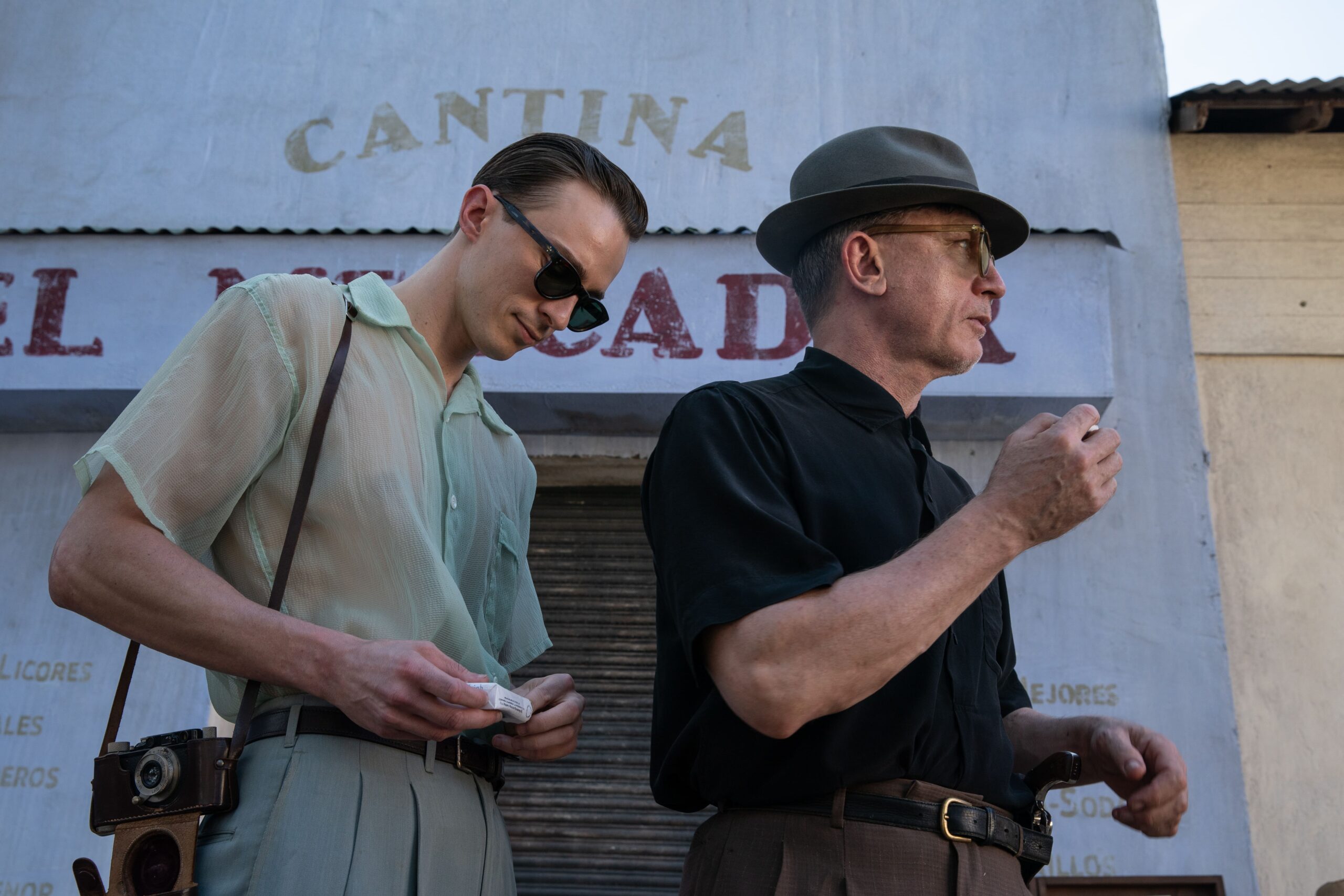Queer – The Searching Hand
For Luca Guadagnino, the matter of desire – of longing for someone – is a profoundly serious one: a wandering hand that advances hesitantly, yearningly, tenderly, but always holds back along the way. Touching the object of desire means simultaneously dispelling its magic, bringing it into the physical realm, giving it tangible form, and thus, dissipating it. Guadagnino plays extensively with this gesture of the searching hand. Both in Io Sono L’Amore (2009) and Call Me by Your Name (2017) – two films fundamentally about the power of desire – the protagonists magnetize each other, caught in a push-and-pull dynamic that draws them close, only to make them retreat, sometimes inevitably and inexplicably.
In Queer, Guadagnino builds on this idea of desire, but he does so in a far darker way. The film is cavernous, locked in nightmares, confined within a thousand boxes and thoughts, grotesque, feverish, sweaty, overwrought. Here, the only problem with intimacy and love is that, in their normal, physical form, they are not enough for the protagonist, Lee. Love must go beyond flesh, beyond skin, beyond mere sexual organs. At one point, the protagonists watch Jean Cocteau’s Orpheus (1950) – the moment when Jean Marais fully steps into a mirror, abandoning the tangible world and entering the Underworld. For Guadagnino, the metaphor is ideal: it represents the way Lee longs to dissolve completely, to disappear, to transform into a gaseous form (or “a thick cloud of love”, as Burroughs puts it in his novel).

Lee is a queer Burroughsian character – meaning he is an autofictional invention of William S. Burroughs, through which the American writer exorcises his experiences in Mexico and his struggle with addiction. He is played by a cisgender actor – Daniel Craig, who, by coincidence, is something of an avatar of potent, maximalist masculinity, making it difficult to separate him from his Bond image. Out of this somewhat odd, mismatched pairing, Craig delivers a strange performance – faithful to the novel but ultimately tense: he is suffering, lonely, verbose, an elegant buffoon with outrageous jokes. He seeks a form of love that is total, telepathic, platonic – so romantic that it dissolves the senses. To this end, he develops an intense fixation on a former American soldier, Eugene Allerton (Drew Starkey), who drifts through the same shapeless, sleepy gay bars that Lee frequents. Unlike Lee, Allerton is extremely reserved, a man of few words – often responding to Lee’s musings with a smile or an ambiguous laugh, making it unclear whether he is queer or simply exploring. This lack of clarity drives Lee mad, leading him to consider other ways to communicate with Allerton. His main idea is to travel to South America and take ayahuasca with him, having heard of its telepathic properties. In Burroughs’ novel, the jungle quest ends in failure – the two never manage to obtain the magic brew. But Guadagnino takes the fantasy much further: he transforms Dr. Cotter into a manic researcher (Lesley Manville is fantastic in the role, as is her husband, played by filmmaker Lisandro Alonso) and includes them in Lee and Allerton’s sensorial-romantic experience in a truly unexpected way. At this point, Queer takes on a surreal, almost dreamlike quality.
For Luca Guadagnino, the matter of desire – of longing for someone – is a profoundly serious one: a wandering hand that advances hesitantly, yearningly, tenderly, but always holds back along the way. Touching the object of desire means simultaneously dispelling its magic, bringing it into the physical realm, giving it tangible form, and thus, dissipating it. In Queer, Guadagnino builds on this idea of desire, but he does so in a far darker way. The film is cavernous, locked in nightmares, confined within a thousand boxes and thoughts, grotesque, feverish, sweaty, overwrought.
More than once, I get the feeling of a temporal dissonance – a kind of sonic anachronism created by Nirvana’s music, Sinéad O’Connor’s cover of All Apologies, Trent Reznor and Atticus Ross’ score, a series of costumes and gestures, and the characters themselves, who feel deliberately placed. The year may be 1950, but the sensation is that these people exist entirely outside of time. The sets, assembled at the legendary Cinecittà Studios, resemble tableaux vivants in the style of Edward Hopper – bathed in artificial light, with rosy, fabricated sunsets, and painted, blood-red clouds. Even the jungle, lush and vibrant, is entirely constructed on the hills of the Italian studio. The movements within the frame are minimal – people strolling apathetically, holding flowers; fruit vendors polishing their wares contemplatively. I get the sense that there is no real life to be lived – neither inside the frame nor outside it. The overwhelming beauty and symmetry – even in the painted mildew – somehow contradict the decrepit life of crime and danger described by Burroughs. Here, the streets are rarely populated, and cars pass by only occasionally.

But then, of course, there’s the surrealist element with which Guadagnino infuses Burroughs’ world. Where Burroughs merely suggests, Guadagnino goes wild. At a certain point, it becomes clear that this world orbits around Lee because it is made in his image and likeness – it is his emanation. Nothing is entirely real here (Guadagnino places Lee in many hallucinations referencing symbols from Burroughs’ work and his stranger-than-fiction life, especially the murder of his former wife, which Burroughs himself attributed to demonic possession). And this is where the film diverges significantly from the novel – probably the reason Queer takes on this strange, almost impenetrable allure, functioning only for itself and those deeply familiar with Burroughs. It is a rhetorical dream of colossal magnitude – a queer Xanadu, if you will.
Title
Queer
Director/ Screenwriter
Luca Guadagnino
Actors
Daniel Craig, Drew Starkey, Jason Schwartzman, Lesley Manville
Country
Italy, USA
Year
2024
Distributor
Transilvania Film
Journalist and film critic, with a master's degree in film critics. Collaborates with Scena9, Acoperișul de Sticlă, FILM and FILM Menu magazines. For Films in Frame, she brings the monthly top of films and writes the monthly editorial Panorama, published on a Thursday. In her spare time, she retires in the woods where she pictures other possible lives and flying foxes.


